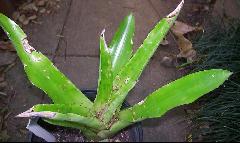
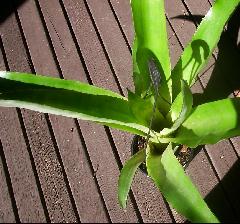
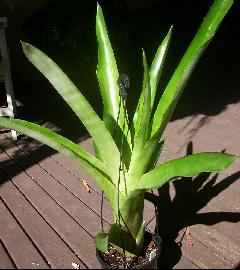
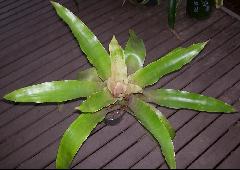
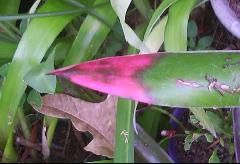
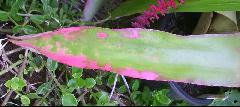
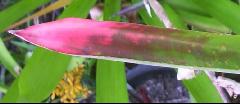
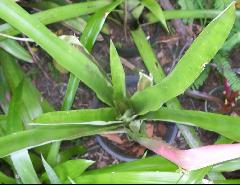
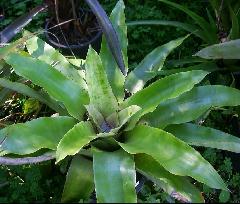
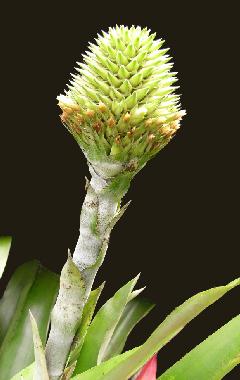
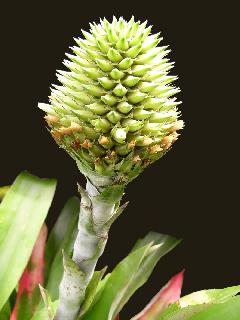
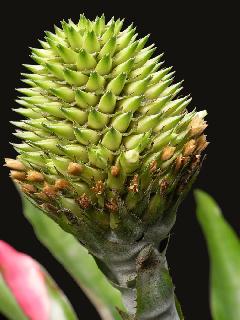
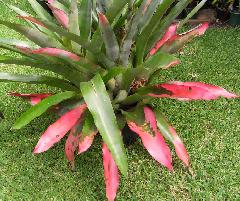
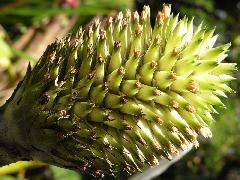
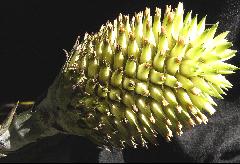
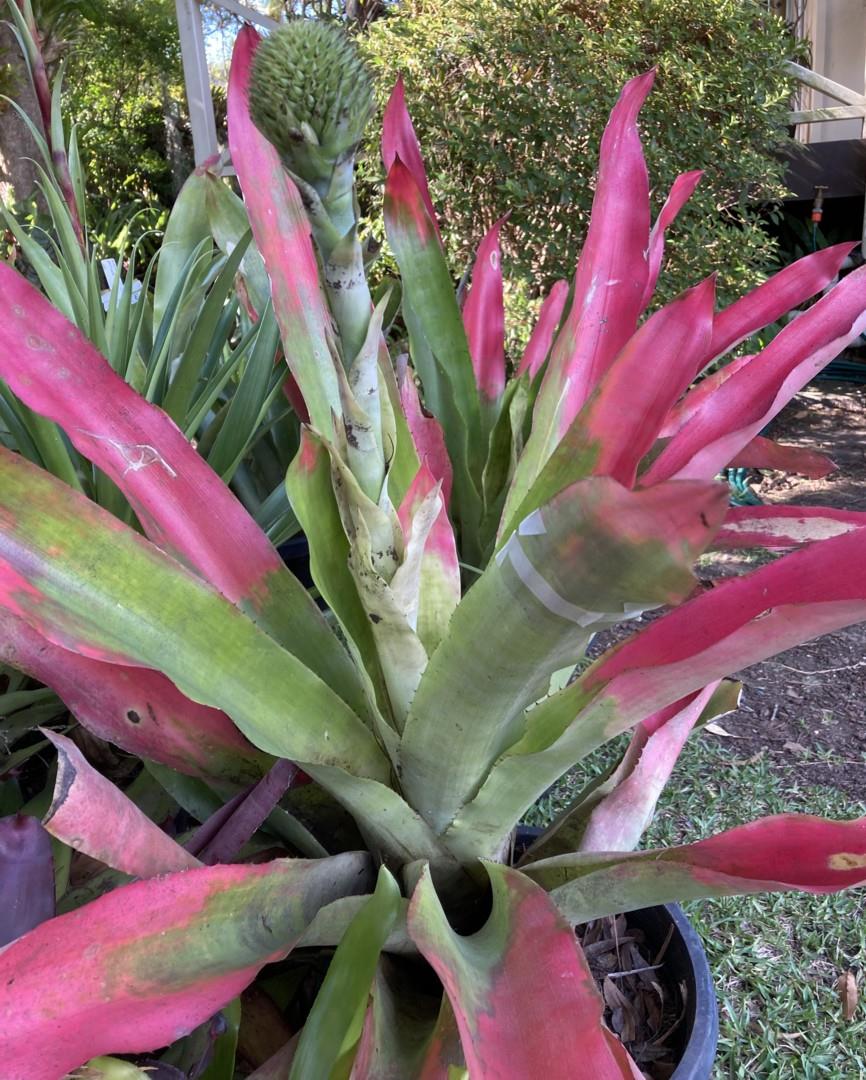
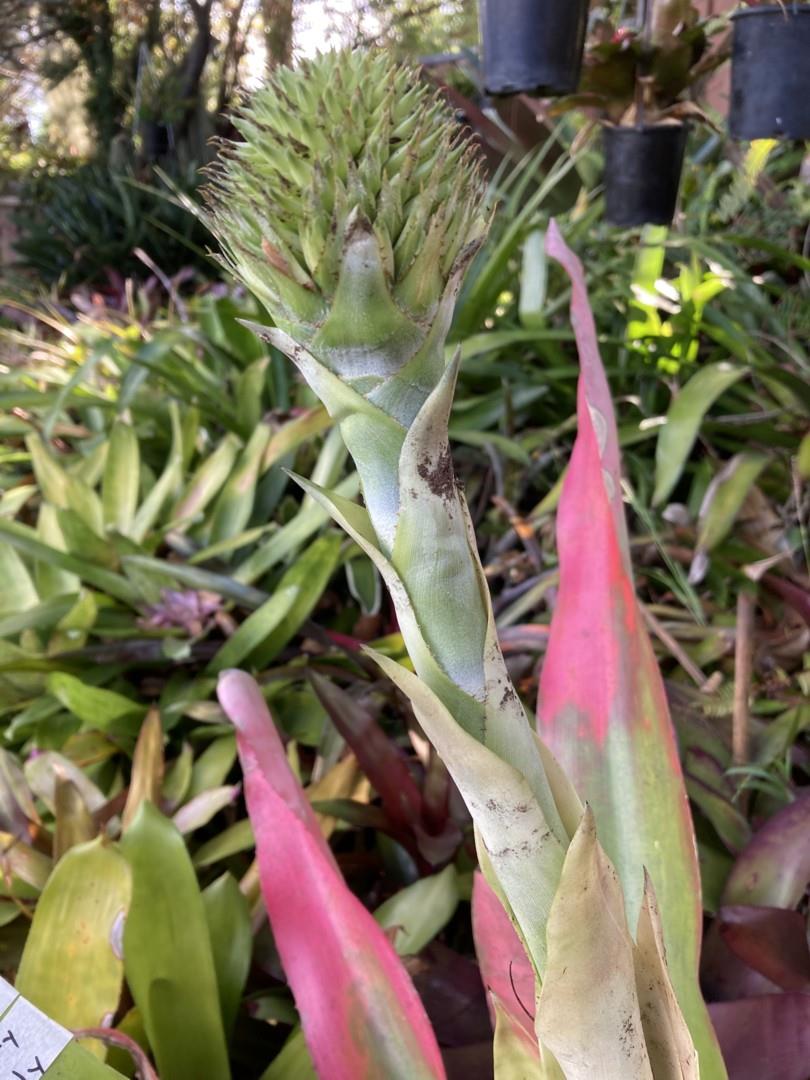
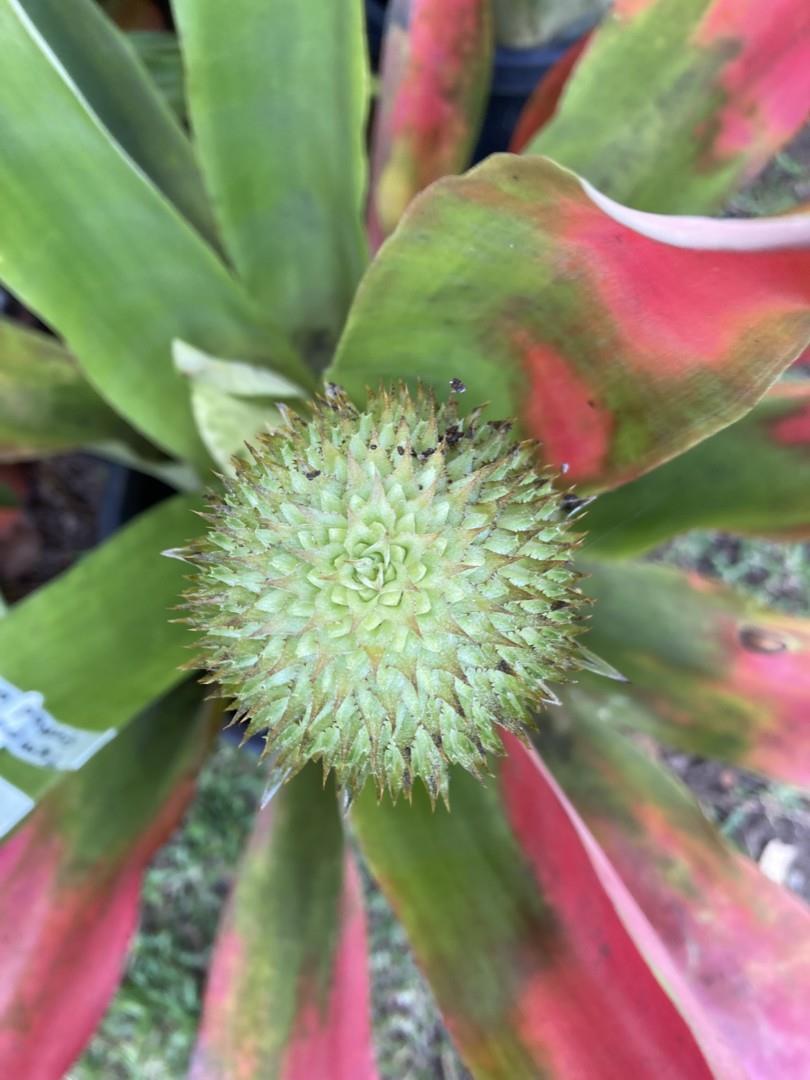
Desc from S&D
Plant flowering 4-7 dm high.
Leaves about 10-15 in a dense funnelform rosette, 39 dm long, covered on both sides with a pale membrane of coalesced scales;
Sheaths large, broadly elliptic but sometimes not much wider than the blades, brown toward base;
Blades ligulate, broadly acute or subrounded, then attenuate to a long pungent involute-subulate apex, flat, 6-9 cm wide, wholly green but turning red at anthesis, serrate with dark curved spines 2.5 mm long.
Scape erect, stout;
Scape-bracts densely imbricate and covering the scape, foliaceous, densely serrate with stout spines.
Inflorescence simple, stout-cylindric or subellipsoid, densely many-flowered, 6-10 cm long, 5-6 cm in diameter.
Floral bracts ovate or lanceolate, acuminate to a brown pungent spine, slightly exceeded by the sepals, densely serrate with coarse dark spreading spines, covered on both sides with a pale membrane of fused scales;
Flowers sessile.
Sepals asymmetric, subovate, acuminate to a slender spine, carinate, 17 mm long, connate for 2 mm, densely pale-lepidote like the ovary;
Petals ligulate, rounded and apiculate, 16-18 mm long, greenish, bearing 2 obtuse scales at base;
Stamens with filaments of the second series highly adnate to the petals;
Ovary sub cylindric; placentae extending nearly the whole height of the cell; ovules caudate.
Type. Burchell 3594 (holotype K; photo GH), Serra de Cubatao, Sao Paulo, Brazil, 13 Dec 1826.
Distribution. Epiphytic, saxicolous, and terrestrial, from near sea level to ca 1100 m alt, Rio de Janeiro to Santa Catarina, Brazil.
BRAZIL. Rio de Janeiro: Serra dos Orgaos, Dec 1891, Ule 1984 (R); Restinga de Maua, Nov 1896, Ule 4136 (CORD, R). (Guanabara): Tijuca, 1885, Glaziou 15484 (C, F photo 22318; G); Praia de Sernambetiba (Recreio dos Bandeirantes), 4 Apr 1952, L. B. Smith & Mus. R. 6818 (R, US); 6819 (R, US); 6820 (US); 6821 (US); 10 Nov 1963, Santos 520 (R); 19 Nov 1964, 5659 (R); 5660 (R); 5661 (R); 5662 (R); 5663 (R). Sao Paulo: Alto da Serra, 12 Jan 1924, Hoehne s n (SP); 11 Feb 1929, L. B. Smith 1841 (GH, S); 18 Aug 1939, Foster 360 (GH, R); Cubatao, 2 Mar 1929, L. B. Smith 2045 (GH); Monte Japui, Sao Vicente, 8 Mar 1929.
Aechmea pectinata by T Wendt in B J of Linnean Soc. 125: 245-271. 1997
Aechmea pectinata Baker, J. Bot. 17: 233 (1879).
Type: Burchell 3594, Serra de Cubatao, State of Sao Paulo, Brazil, 13.x.1826, (K holotype; GH, US, RB photos).
= Pothuava pectinata (Baker) L.B.Sm. & W J. Kress, Phytologia 66(1):76. 1989; syn. nov.
PLANTS flowering c. 50-150 cm high.
LEAF BLADES green, dark-green spotted or not, turning red at the anthesis, linear, 18-96 x 4.5-10 cm, apically pungent 5-15 mm long, serrate with spines up to 2 mm long.
LEAF SHEATHS white-green, elliptic, 12-24 x 9-15.5 cm.
SCAPE erect, cream, 44-62 cm long.
SCAPE BRACTS green or yellow-green, linear, rarely, 3-5 x 1-6.5 cm, apically pungent 3-7 mm long, serrulate, densely imbricate, erect, covering the scape.
INFLORESCENCE strobiliform, 4.5-10 x 4.5-6 cm.
FLORAL BRACTS green, ovate to broadly ovate, papery, 8-30 x 5-25 mm, apically acuminate up to 4 mm long, densely serrate, not carinate, slightly concave without enfolding the ovaries.
FLOWERS 2.5-3.5 cm long.
SEPALS fused for 2-4 mm, ovate, slightly asymmetric, 18-20 x 6 mm, apically acuminate, 2-6 mm long, two sepals are carinate.
PETALS white with their apex greenish, spatulate, 20-25 x 5-6 mm, apically obtuse and apiculate, bearing 2 entire appendages at base c. 2 mm.
STAMENS with filaments 16 mm long and anthers 6 mm long.
OVARY 4-ang1ed, slightly compressed, 7-13 x 6-13 mm; ovules many, caudate, 1 mm long.
FRUIT 4-angled, c. 15 x 15 mm; many club shaped seeds c. 2 x 1 mm.
Distribution and habitat
A. pectinata is known from the States of Rio de Janeiro, Sao Paulo, Parana and Santa Catarina (See map). Growth is epiphytic, saxicolous, rupicolous and terrestrial in Atlantic rain forest and sandy coastal plains ('restingas'), at altitudes between sea level and 1100 m.
Notes
A. pectinata was described by Baker ( 1879) who treated it in the section Pothuava along with A. pineliana, A. nudicaulis and a further seven species that no longer belong to the subgenus Pothuava. Later, Baker (1889) included this taxon in the subgenus Pectinaria near A. fasciata (Lindl.) Baker and A. dealbata E. Morren ex Baker. Morphologically these species have similar serrate floral bracts. Mez (1896) considered A. crocophylla (E. Morren) Baker as a synonym of A. pectinata. A. crocophylla was placed by Baker (1889) in the subgenus Chevaliera. Mez (1892) included this taxon in the subgenus Echinostachys with other species such as A. pineliana, A. vanhoutteana, A. squarrosa and A. triticina and later included the subgenus Echinostachys in Pothuava (Mez, 1896). Smith & Downs (1979) were in agreement with the placing of A. pectinata in Pothuava. The serrate floral bracts of this taxon distinguish it from other Pothuava species. It has some similarities with A. vanhoutteana: both have floral bracts slightly concave, not enfolding the ovaries, not carinate, apically acuminate, but not ending in a spine.
Collections examined
BRAZIL, RIO DE JANEIRO: Angra dos Reis - 23.iii. 1977 , Martinelli 1366 (RB). Mage - xi.1896, Ule 4136 (R). Mangaratiba - 05.xi.1967, Sucre 1891 (RB). Nova Iguacu – 05 .xii. 1987 , Wendt 177 & Fontoura (RB). Parati – 10 i. 1974, Martinelli 531 (RB). Petropolis – 15 .x. 1967, Pereira 10634 & Braga (HB). Rio de Janeiro - 30.viii.1943, Voll s.n. (RB); 04.iv.19S2, Smith 6819 (R); 10.xi.1963, Santos 520 (R); 10.ii.1988, Araujo 8521 (GUA). Teresopolis - xii.1891, Ule 1984 (R); 18.xi.1952, Vidal II -5195 (R); 31.xii.1967, Pereira 10650 (HB); 2l.x.1977 , Martinelli 3333 & Maas (RB). SAO PAULO: Cananeia- 07.x.1980, Wanderly 232 (SP); 1l.iii.1982, Barros 712 (SP); 06.iv.1988, Wanderley, Mercier & Mello 998 (SP); 03.xii. 1990, Barros 2020 (SP). Caraguatatuba 10.xii.1961, Castellanos 23199 (GUA). Cubatao - 13.xii.1826, Burchell 3594 (K, GH, US, RB). Guaruja – 05. ii.1968, Smith & Mc Williams 15373 (R). Iguape - 21.xi. 1990, Rossi 768 (SP). Itanhaem - 19.i.1985, Araujo 6533 (GUA). Santos - 26.x. 1934, Lamber 9 (SP). Ubatuba - 08.iii.1978, Clara s.n. (RB). PARANA: Guaratuba - 21.ii.19S2, Smith & Reitz 5745 (R); 30.viii.1939, Foster 433 (R, US); 31.viii.1939, Kuhlmann s.n. (SP). Paranagua- 31.i.1960, 29.xii.1962, 31.i.1966, 28.vii.1973, Hatschbach 6706, 9875, 13639, 32252 (MBM). SANTA CATARINA: Sao Francisco do Sul - 21.ii.1952, Smith & Reitz 5706 (R, RB).
Protologue
49. Aechmea pectinata Baker, n. sp. Jour. Bot. London 17: 233. 1879.
Leaves large, not seen their full length, two and a half to three inches broad above the dilated base, with hooked black horny prickles one-eighth of an inch long. Scape one foot and a half long, quite hidden by its numerous large imbricated coriaceous bract-leaves, of which the lower reach a foot in length, but the upper only one inch and a half to two inches, all of them furnished with close brown-black horny teeth down the edge. Flowers in a dense oblong head three inches long, two inches in diameter. Flower-bracts deltoid-cuspidate, with close large black horny teeth down the edge, the uppermost as long as the calyx, the lower quite an inch long. Calyx with ovary three-quarters of an inch long. Sepals lanceolate, minutely cuspidate, longer than the ovary. Petals not seen.
South Brazil in the province of St. Paulo on the Serra de Cubatao, Burchell, 3594 ! (Herb. Kew.)